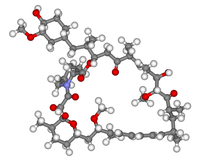
Photo from wikipedia
Musculoskeletal diseases and disorders, including osteoporosis and rheumatoid arthritis are diseases that threaten a healthy life expectancy, and in order to extend the healthy life expectancy of elderly people, it… Click to show full abstract
Musculoskeletal diseases and disorders, including osteoporosis and rheumatoid arthritis are diseases that threaten a healthy life expectancy, and in order to extend the healthy life expectancy of elderly people, it is important to prevent bone and joint diseases and disorders. We previously reported that alymphoplasia (aly/aly) mice, which have a loss-of-function mutation in the Nik gene involved in the processing of p100 to p52 in the alternative NF-κB pathway, show mild osteopetrosis with a decrease in the osteoclast number, suggesting that the alternative NF-κB pathway is a potential drug target for ameliorating bone diseases. Recently, the novel NF-κB-inducing kinase (NIK)-specific inhibitor compound 33 (Cpd33) was developed, and we examined its effect on osteoclastic bone resorption in vitro and in vivo. Cpd33 inhibited the receptor activator of NF-κB ligand (RANKL)-induced osteoclastogenesis accompanied by a decrease in the expression of nfatc1, dc-stamp, and cathepsin K, markers of osteoclast differentiation, without affecting the cell viability, in a dose-dependent manner. Cdp33 specifically suppressed the RANKL-induced processing of p100 to p52 but not the phosphorylation of p65 or the degradation or resynthesis of IκBα in osteoclast precursors. Cpd33 also suppressed the bone-resorbing activity in mature osteoclasts. Furthermore, Cdp33 treatment prevented bone loss by suppressing the osteoclast formation without affecting the osteoblastic bone formation in ovariectomized mice. Taken together, NIK inhibitors may be a new option for patients with a reduced response to conventional pharmacotherapy or who have serious side effects.
Journal Title: Bone
Year Published: 2020
Link to full text (if available)
Share on Social Media: Sign Up to like & get
recommendations!